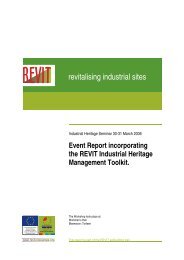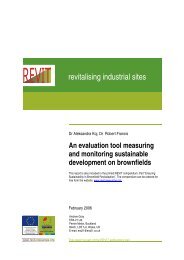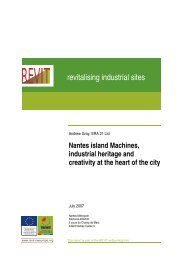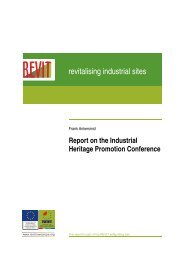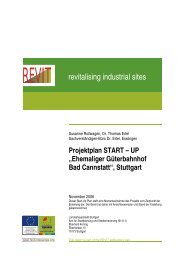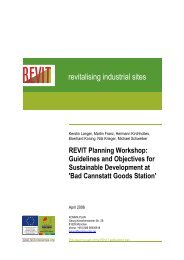REVIT Heritage Report.pdf
REVIT Heritage Report.pdf
REVIT Heritage Report.pdf
You also want an ePaper? Increase the reach of your titles
YUMPU automatically turns print PDFs into web optimized ePapers that Google loves.
Torfaen County Borough Council<br />
<strong>REVIT</strong>: A Review of the Conservation of Industrial <strong>Heritage</strong> Assets on Brownfield Sites<br />
maritime history. The site now contains more than 100 small businesses and<br />
organisations and over 400 residents.<br />
4.3.8 The abandonment of Chatham Dockyard by the Royal Navy in 1984 left many<br />
important historic maritime structures without a function. New and innovative<br />
economic functions were, therefore, required in order to maintain the dockyard.<br />
This required the establishment of an overall conservation and design strategy<br />
for the site as a whole and for the re-use of existing features.<br />
4.3.9 Some of the re-uses of the existing buildings and structures include:<br />
• The Clock Tower Building: dating from 1723, it is a Scheduled Ancient<br />
Monument and Grade II* Listed Building and is oldest naval storehouse to<br />
survive in any of the Royal Dockyards. It was built as a store for materials<br />
and equipment needed by ships under construction and repair with a Mould<br />
Loft and the six ground floor bays at the north end of the structure were left<br />
open and used as saw pits. The Clock Tower building has been restored<br />
and used as the Bridgewarden’s College of the University of Kent;<br />
• The Mast Houses and Mould Loft: dating from 1753-58, it is a Scheduled<br />
Ancient Monument & Grade I Listed Building. It contains a range of seven<br />
timber framed mast houses, built largely from reused warship timbers.<br />
Today the building houses the Wooden Walls gallery;<br />
• Nos. 4, 5 & 6 Covered Slips: dating from 1847-48, they are Scheduled<br />
Ancient Monuments & Grade I Listed Buildings. The structures are a range<br />
of three identical early cast iron slip covers with corrugated iron roof<br />
sheeting. The slips now house the Royal National Lifeboat Institute’s<br />
(RNLI) collection of Historic Lifeboats;<br />
• Wheelwrights Shop: dating from c. 1786, it is a Scheduled Ancient<br />
Monument & Grade II* Listed Building. It was built as a three bay Mast<br />
House. Beneath the floor lay the Mary Rose warship. The Wheelwrights<br />
Shop now houses the Historic Dockyard’s restaurant;<br />
• House Carpenters Shop: dating from 1740, it is a Scheduled Ancient<br />
Monument & Grade II Listed Building. It was built for the carpenters who<br />
looked after the dockyard’s own buildings. The building now forms part of a<br />
series of craft workshops;<br />
• The Ropery: dating from 1786-91, it is a Scheduled Ancient Monument &<br />
Grade I Listed Building. The buildings of the Ropery form one of the finest<br />
integrated groups of 18th Century manufacturing buildings in Britain.<br />
Machinery dating from 1811 remains in regular use and on display to<br />
visitors;<br />
• Anchor Wharf Storehouses: dating from 1778-1805, it is a Scheduled<br />
Ancient Monument & Grade I Listed Building. It consisted of two great<br />
storehouses on Anchor Wharf. At nearly 700 feet long (210 metres) it is<br />
the largest storehouse built for the Royal Navy in Britain. Together with<br />
surviving examples in Portsmouth they are some of the most significant<br />
examples of early industrial warehousing in Europe. The Fitted Rigging<br />
House and Storehouse No. 2 now houses the Museum of The Royal<br />
Dockyard;<br />
• No. 3 Dry Dock: dating from 1820, it is a Scheduled Ancient Monument and<br />
Grade II* Listed Building. It houses HM Submarine Ocelot, the last warship<br />
built for the Royal Navy. Many of the other Victorian Covered Slipways and<br />
0014021/JM/001 27




